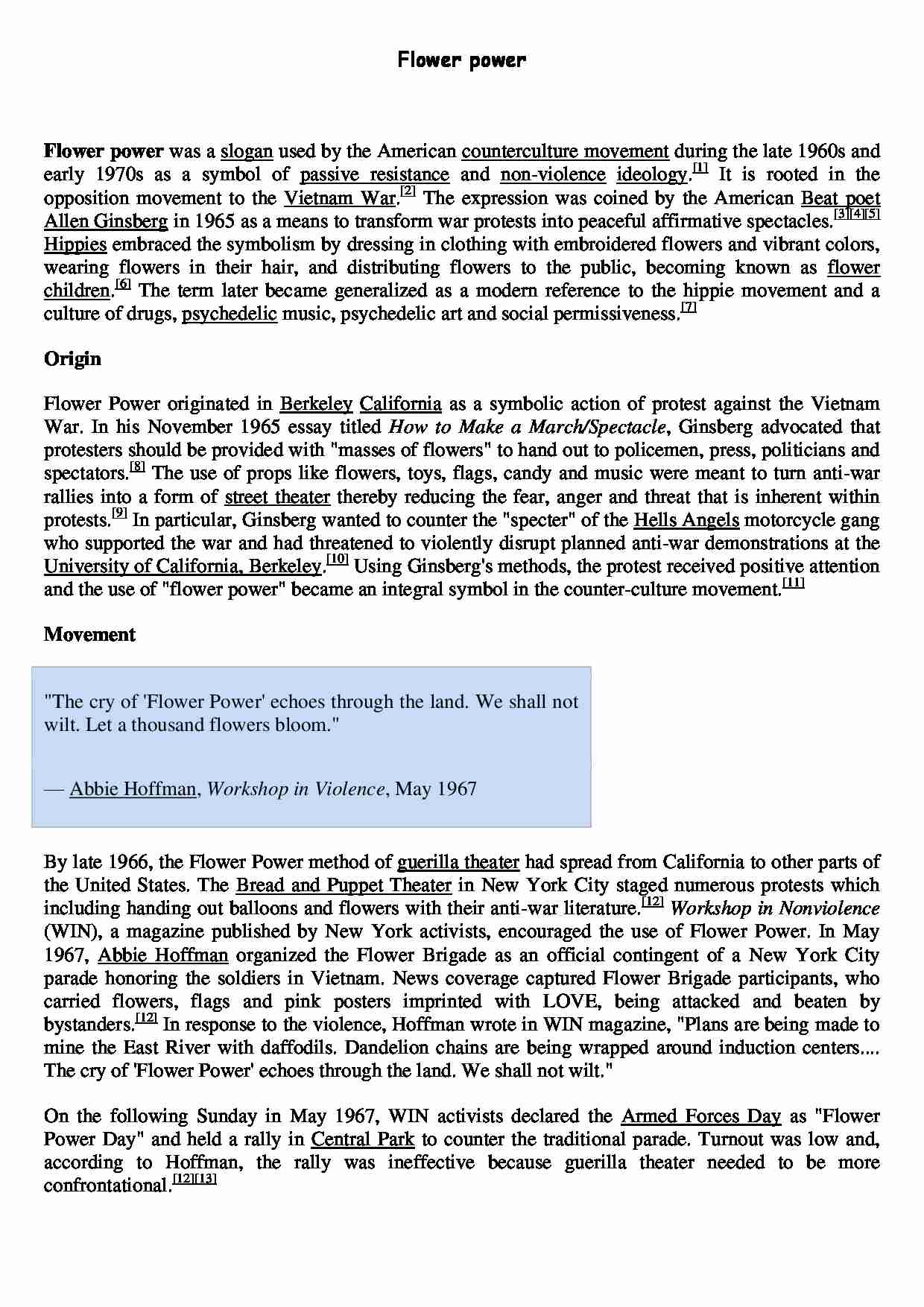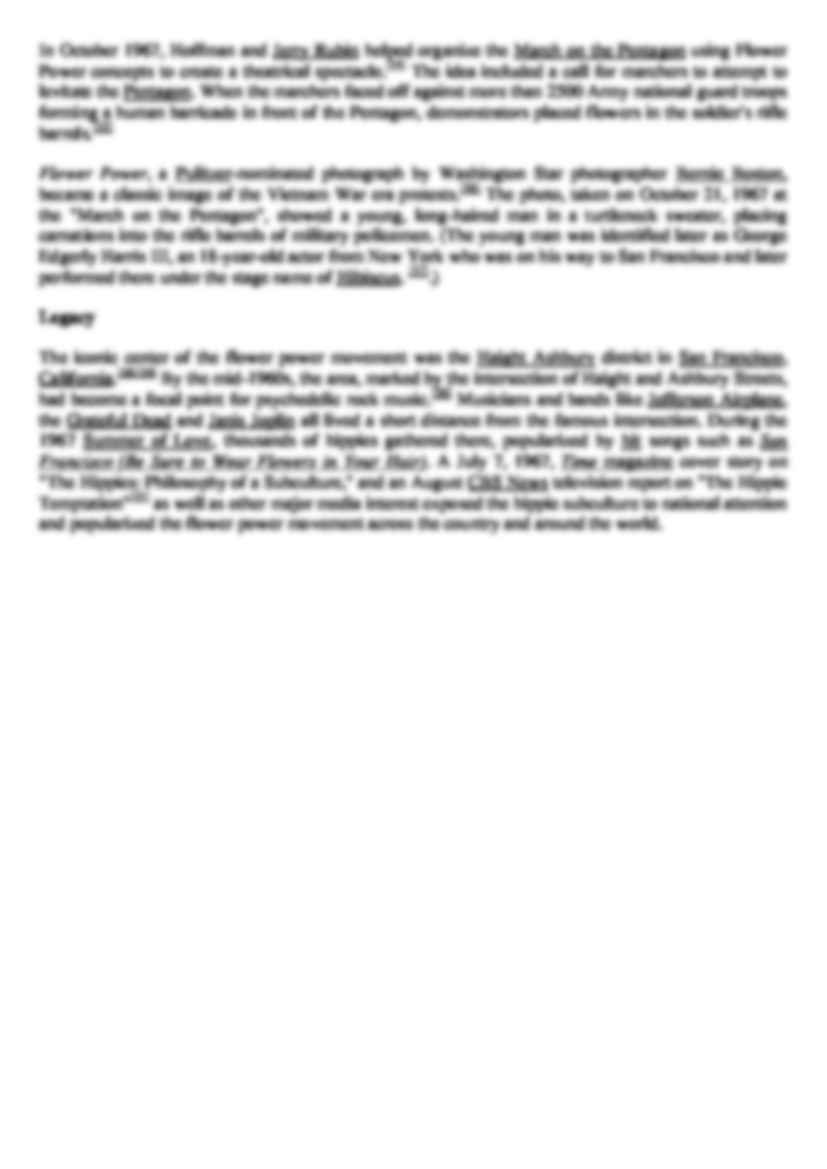Flower power
Flower power was a slogan used by the American counterculture movement during the late 1960s and early 1970s as a symbol of passive resistance and non-violence ideology.[1] It is rooted in the opposition movement to the Vietnam War.[2] The expression was coined by the American Beat poet Allen Ginsberg in 1965 as a means to transform war protests into peaceful affirmative spectacles.[3][4][5] Hippies embraced the symbolism by dressing in clothing with embroidered flowers and vibrant colors, wearing flowers in their hair, and distributing flowers to the public, becoming known as flower children.[6] The term later became generalized as a modern reference to the hippie movement and a culture of drugs, psychedelic music, psychedelic art and social permissiveness.[7]
Origin
Flower Power originated in Berkeley California as a symbolic action of protest against the Vietnam War. In his November 1965 essay titled How to Make a March/Spectacle, Ginsberg advocated that protesters should be provided with "masses of flowers" to hand out to policemen, press, politicians and spectators.[8] The use of props like flowers, toys, flags, candy and music were meant to turn anti-war rallies into a form of street theater thereby reducing the fear, anger and threat that is inherent within protests.[9] In particular, Ginsberg wanted to counter the "specter" of the Hells Angels motorcycle gang who supported the war and had threatened to violently disrupt planned anti-war demonstrations at the University of California, Berkeley.[10] Using Ginsberg's methods, the protest received positive attention and the use of "flower power" became an integral symbol in the counter-culture movement.[11]
Movement
"The cry of 'Flower Power' echoes through the land. We shall not wilt. Let a thousand flowers bloom."
— Abbie Hoffman, Workshop in Violence, May 1967
By late 1966, the Flower Power method of guerilla theater had spread from California to other parts of the United States. The Bread and Puppet Theater in New York City staged numerous protests which including handing out balloons and flowers with their anti-war literature.[12] Workshop in Nonviolence (WIN), a magazine published by New York activists, encouraged the use of Flower Power. In May 1967, Abbie Hoffman organized the Flower Brigade as an official contingent of a New York City parade honoring the soldiers in Vietnam. News coverage captured Flower Brigade participants, who carried flowers, flags and pink posters imprinted with LOVE, being attacked and beaten by bystanders.[12] In response to the violence, Hoffman wrote in WIN magazine, "Plans are being made to mine the East River with daffodils. Dandelion chains are being wrapped around induction centers.... The cry of 'Flower Power' echoes through the land. We shall not wilt."
On the following Sunday in May 1967, WIN activists declared the
(…)
… following Sunday in May 1967, WIN activists declared the Armed Forces Day as "Flower Power Day" and held a rally in Central Park to counter the traditional parade. Turnout was low and, according to Hoffman, the rally was ineffective because guerilla theater needed to be more confrontational.[12][13]
In October 1967, Hoffman and Jerry Rubin helped organize the March on the Pentagon using Flower Power…
… performed there under the stage name of Hibiscus. [17].)
Legacy
The iconic center of the flower power movement was the Haight Ashbury district in San Francisco, California.[18][19] By the mid-1960s, the area, marked by the intersection of Haight and Ashbury Streets, had become a focal point for psychedelic rock music.[20] Musicians and bands like Jefferson Airplane, the Grateful Dead and Janis Joplin all…
… performed there under the stage name of Hibiscus. [17].)
Legacy
The iconic center of the flower power movement was the Haight Ashbury district in San Francisco, California.[18][19] By the mid-1960s, the area, marked by the intersection of Haight and Ashbury Streets, had become a focal point for psychedelic rock music.[20] Musicians and bands like Jefferson Airplane, the Grateful Dead and Janis Joplin all…
... zobacz całą notatkę




Komentarze użytkowników (0)